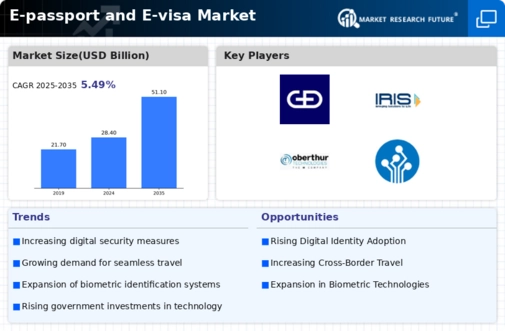Market Share
E-passport E-visa Market Share Analysis
In the fiercely competitive landscape of the E-passport and E-visa market, companies deploy strategic market share positioning strategies to distinguish themselves, capture market share, and meet the evolving needs of governments and travelers. A pivotal strategy involves continuous technological innovation, where companies invest in research and development to enhance the security and features of their E-passports and E-visas. Staying at the forefront of technological advancements allows companies to position their products as cutting-edge, secure, and capable of addressing emerging challenges, thereby gaining a competitive advantage.
Strategic partnerships and collaborations are integral to market share positioning within the E-passport and E-visa sector. Companies often form alliances with technology providers, security experts, and government agencies to leverage collective expertise, share resources, and collectively advance the capabilities of electronic identification systems. These collaborations not only contribute to the development of more secure and interoperable solutions but also position the companies involved as leaders fostering innovation and industry-wide collaboration.
A customer-centric approach is essential for gaining and maintaining market share in the E-passport and E-visa sector. Companies that prioritize user experience, ease of use, and customization options create strong value propositions. Offering user-friendly interfaces, efficient visa application processes, and responsive customer support contribute to customer satisfaction and loyalty. A satisfied customer base not only leads to repeat business but also serves as a powerful asset in attracting new customers and expanding market share.
Strategic pricing is a critical component of market share positioning in the E-passport and E-visa market. Some companies focus on offering cost-effective solutions, targeting a broad customer base and governments with budget constraints. Others position themselves as premium providers, emphasizing advanced security features, additional services, and superior customer support. Strategic pricing allows companies to cater to specific market segments, optimizing market share based on the perceived value of their E-passports and E-visas.
Investment in marketing and brand positioning is a fundamental strategy for companies aiming to secure and enhance their market share. Effective marketing campaigns, participation in industry events, and thought leadership initiatives contribute to building brand recognition and trust. Companies that successfully position themselves as reputable and reliable providers of electronic identification solutions can influence customer preferences, gain market share, and establish a strong foothold in the competitive E-passport and E-visa market.
Geographical expansion is a market share positioning strategy often employed by companies seeking to tap into new markets and regions. Understanding the unique requirements and regulatory environments of different geographic areas allows companies to tailor their E-passports and E-visas to meet specific local needs. This strategy enables companies to diversify their customer base, reduce dependency on specific markets, and position themselves as global leaders in the E-passport and E-visa market.
Environmental sustainability considerations are becoming influential in market share positioning within the E-passport and E-visa sector. Companies that emphasize eco-friendly practices, such as the reduction of physical documents and the use of sustainable materials, align with the growing demand for environmentally conscious solutions. This strategy positions companies as socially responsible leaders in the E-passport and E-visa market, appealing to environmentally conscious customers and stakeholders and influencing market share positively.
The focus on continuous improvement and adaptability is a dynamic strategy in the E-passport and E-visa market. Companies that actively seek feedback, monitor industry trends, and respond quickly to emerging challenges position themselves as agile and innovative players. This strategy enables companies to proactively address market demands, stay ahead of the competition, and maintain a flexible market share positioning that aligns with the rapidly evolving landscape of electronic identification systems.







Leave a Comment